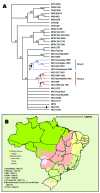Brazilian vaccinia viruses and their origins
- PMID: 18214166
- PMCID: PMC2878226
- DOI: 10.3201/eid1307.061404
Brazilian vaccinia viruses and their origins
Abstract
Although the World Health Organization (WHO) declared global smallpox eradicated in 1980, concerns over emergent poxvirus infections have increased. Most poxvirus infections are zoonotic; exploring their genetic diversity will illuminate the genetic and evolutionary aspects of poxvirus infections, ecology, and epidemiology. In recent decades, several strains of the orthopoxvirus vaccinia virus (VACV) have been isolated throughout Brazil, including genetically distinct isolates within the same outbreak. To further investigate the diversity and origins of these viruses, we analyzed molecular data from 8 Brazilian VACV isolates and compared several genes involved in virus structure and pathogenicity. Genetic variation among isolates suggests that ancestral Brazilian VACVs existed before the beginning of the WHO smallpox eradication vaccination campaigns and that these viruses continue to circulate.
Figures



References
-
- Fenner F, Henderson DA, Arita I, Jezek Z, Ladnyi ID. Smallpox and its eradication. Geneva: World Health Organization; 1988.
MeSH terms
LinkOut - more resources
Full Text Sources
Other Literature Sources
